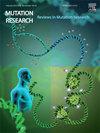CUEDC1通过TGF-β/Smad信号通路促进肝癌细胞生长、迁移、上皮-间质转化、抑制凋亡
IF 1.9
4区 医学
Q4 BIOTECHNOLOGY & APPLIED MICROBIOLOGY
Mutation Research-Fundamental and Molecular Mechanisms of Mutagenesis
Pub Date : 2025-01-01
DOI:10.1016/j.mrfmmm.2025.111900
引用次数: 0
摘要
目的探讨位于染色体17q22上含有CUE结构域的42 kDa蛋白CUEDC1参与肝癌转移的精确分子机制。方法采用Western blot法检测肝癌细胞中cuedc1蛋白的表达水平。通过siRNA转染使CUEDC1在这些细胞中的表达沉默,使用细胞计数试剂盒-8 (CCK-8)测定细胞活力。采用Transwell法评估细胞侵袭和迁移能力。Western blot检测小鼠抗十肢瘫痪(Smad)通路转化生长因子-β (TGF-β)/小母细胞、N-cadherin、α-平滑肌肌动蛋白(α-SMA)、E-cadherin的表达。结果cuedc1在肝癌细胞中表达升高。CUEDC1的下调降低了TGF-β、p-Smad2和p-Smad3的表达,这是TGF-β/Smad通路的关键成分。此外,CUEDC1敲低显著降低肝癌细胞的存活、迁移、侵袭和EMT过程。结论cuedc1基因下调通过抑制TGF-β/Smad信号通路,显著降低EMT和肝癌细胞转移。本文章由计算机程序翻译,如有差异,请以英文原文为准。
CUEDC1 promotes the growth, migration, epithelial-mesenchymal transition and inhibits apoptosis of hepatocellular carcinoma cells via the TGF-β/Smad signaling pathway
Purpose
To explore the precise molecular by which CUEDC1, a 42 kDa protein containing a CUE domain located on chromosome 17q22, contributes to liver cancer metastasis.
Method
CUEDC1 protein expression levels were determined in liver cancer cells using Western blot analysis. The expression of CUEDC1 in these cells was silenced through siRNA transfection Cell viability was assessed using the Cell Counting Kit-8 (CCK-8) assay. Cell invasion and migration capabilities were evaluated using Transwell assays. The expression of transforming growth factor-beta (TGF-β)/ small mother against decapentaplegic (Smad) pathway, N-cadherin, alpha -smooth muscle actin (α-SMA), and E-cadherin was detected using Western blot.
Result
CUEDC1 expression was found to be elevated in liver cancer cells. Knockdown of CUEDC1 reduced the expression of TGF-β, p-Smad2, and p-Smad3, key components of the TGF-β/Smad pathway. Additionally, CUEDC1 knockdown significantly decreased cell survival, migration, invasion, and the EMT process in liver cancer cells.
Conclusion
CUEDC1 knockdown markedly reduces EMT and liver cancer cell metastasis by suppressing the TGF-β/Smad signaling pathway.
求助全文
通过发布文献求助,成功后即可免费获取论文全文。
去求助
来源期刊
CiteScore
4.90
自引率
0.00%
发文量
24
审稿时长
51 days
期刊介绍:
Mutation Research (MR) provides a platform for publishing all aspects of DNA mutations and epimutations, from basic evolutionary aspects to translational applications in genetic and epigenetic diagnostics and therapy. Mutations are defined as all possible alterations in DNA sequence and sequence organization, from point mutations to genome structural variation, chromosomal aberrations and aneuploidy. Epimutations are defined as alterations in the epigenome, i.e., changes in DNA methylation, histone modification and small regulatory RNAs.
MR publishes articles in the following areas:
Of special interest are basic mechanisms through which DNA damage and mutations impact development and differentiation, stem cell biology and cell fate in general, including various forms of cell death and cellular senescence.
The study of genome instability in human molecular epidemiology and in relation to complex phenotypes, such as human disease, is considered a growing area of importance.
Mechanisms of (epi)mutation induction, for example, during DNA repair, replication or recombination; novel methods of (epi)mutation detection, with a focus on ultra-high-throughput sequencing.
Landscape of somatic mutations and epimutations in cancer and aging.
Role of de novo mutations in human disease and aging; mutations in population genomics.
Interactions between mutations and epimutations.
The role of epimutations in chromatin structure and function.
Mitochondrial DNA mutations and their consequences in terms of human disease and aging.
Novel ways to generate mutations and epimutations in cell lines and animal models.

 求助内容:
求助内容: 应助结果提醒方式:
应助结果提醒方式:


